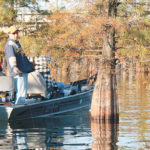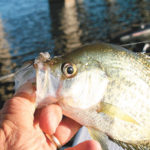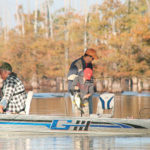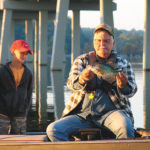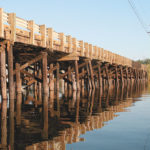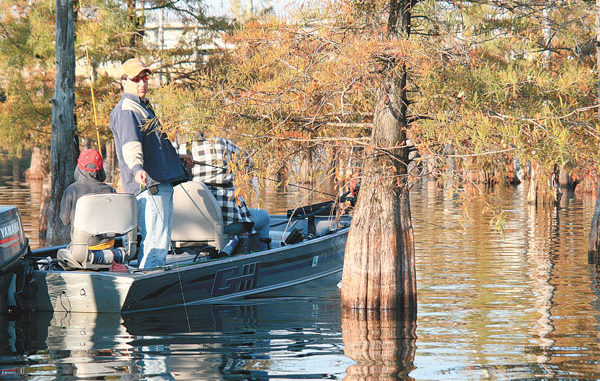
Crappie fishing comes alive on Black Lake
Northwest Louisiana is blessed with a number of beautiful cypress-studded lakes that have long served as magnets for area fishermen. Lakes such as Bistineau, Black, Saline, Iatt and Nantachie were created hundreds of years ago by the Great River Raft, a massive log jam that clogged Red River from about modern-day Boyce to near Shreveport.
As more trees and debris washed into the river, the raft grew steadily upstream, and it acted as a dam whenever it passed the mouth of a bayou. The bayous then pooled up in low swampy areas, and, presto, the lakes were formed.
When Henry Miller Shreve cleared the raft in the 1830s, the lakes drained away, but modern dams were constructed in the early 20th century, and we have been fishing them ever since.
As a youngster, one of my favorite fishing holes was Black Lake near Campti. I can remember sculling an aluminum boat around its trees all day long catching bull bream, white perch and schooling bass.
But white perch were, and still are, my favorite fish.
A Black Lake hotspot has always been the area around the Highway 9 bridge. Every year from October through May, thousands of white perch are hauled out of the dark waters there.
After moving to Northeast Louisiana years ago, I stopped fishing Black Lake, but last October I decided to revisit my childhood after hearing that the bite was on at the bridge.
Jimmie Rowell, of Saline, informed me he had enjoyed several good trips, and offered to meet me there to reacquaint me with my old fishing hole.
“Get there early,” Rowell warned. “It’s an early bite.
“I usually get there about seven and am ready to go by 11. If I have 20 or so by then, I’m ready to go.”
I made the 90-mile drive in good time, and pulled in to Chandler’s Camp before daylight. It was a perfect morning for squirrel hunting with the temperature in the low 50s, a dead calm wind and clear sky. By the time I launched my boat, the sky had brightened, and scattered shotgun blasts echoed around the lake. Obviously, the squirrels were active — but would the fish cooperate?
I decided to go ahead and start fishing, and eased out to the channel. Even though the sun had not yet cleared the horizon, there already were seven boats around and under the bridge.
After putting on a 1/8-ounce gray/chartreuse Black Lake hair jig, I eased down the tree line on the edge of the channel flipping my bait next to the trees and letting it sink about 8 feet. Twice, nice-sized white perch nailed it, but I lost both of them on top of the water. Not a good start, I thought.
About the time I got to the bridge, Rowell pulled up with Heath Mathews and his son, Micah. Of our little group, Mathews was the real bridge veteran.
“I’ve been fishing out here all my life,” he explained. “I originally started out fishing with my dad.”
Mathews, in fact, is the one who taught Rowell the ins and outs of Black Lake bridge fishing.
While some people just tie up to a tree or piling and concentrate on fishing one spot, we opted to troll slowly around the bridge and along the cypress trees seeking hungry fish. As we probed the pilings and nearby cypress trees with our jigs, I probed my partners for more information.
The first thing I learned was that Mathews and Rowell do not rummage through their tackle boxes trying jigs of different type or color. They use one jig almost exclusively — the Gray Ghost.
“I work with a guy, and all he does is fish for white perch,” Mathews said. “He put me on the Gray Ghost.”
The Gray Ghost was designed by nationally famous crappie guide Bob Young, and is marketed online by Jim Porter as one of his “Perfect” Crappie Jigs. As all serious jig fishermen know, the jig has to sit perpendicular to the line to draw a bite. If it hangs straight down, you might as well give up.
A unique feature of the Gray Ghost is that its hook eye is set back on the jig head farther than usual. This makes it always sit perpendicular to the line. When using a Gray Ghost, you don’t have to constantly readjust the jig when you miss a strike or after getting hung up.
It’s about the only bait Rowell uses now.
“I only started fishing jigs last January,” he said. “Heath put me on that Gray Ghost.
“I’d always used shiners, and he showed me how to jig fish. Now it’s my go-to bait no matter where I fish.”
I bought some Gray Ghosts online before the trip, but got the 1/8-ounce size because I like to troll my jig slowly through the water, and the heavier weight keeps it down at the proper depth. After watching my technique, however, Mathews and Rowell quickly informed me I had made a mistake.
“They usually bite on the fall,” explained Mathews.
As a result, you need a lighter head to let it drift slowly down. Mathews and Rowell use the smaller 1/16-ounce jig with 8 to 10 feet of line. As they ease along the bridge pilings and cypress trees, they toss the jig out and let it slowly sink.
“If they don’t hit it while it’s falling, you might as well pick it up and throw it again,” Rowell said. “Sometimes when they’re biting good, I’ll let it all the way down to the bottom and jiggle it a bit and get a bite.”
But you have to pay close attention to your line.
“Seventy percent of the time with the Gray Ghost you don’t feel the bite,” said Rowell. “It pays to watch the line — if it goes slack, set the hook.”
After hearing that, I made a mental note to change out my line to a brighter color next time so I could more easily detect such subtle bites.
I asked Mathews if he ever used a tandem rig so he could fish more than one jig like fishermen do on such legendary white perch lakes as Larto and Poverty Point.
“No,” he replied, “One’s all I can handle.”
I experimented with a tandem rig for awhile, but found out he was right. The extra weight made the jigs fall too quickly through the water column, and I constantly got hung up when fishing near the cypress trees.
I also asked if they ever used crappie nibbles on the jigs. Nodding toward his son, Mathews told me, “Micah does, but I don’t.”
Several times during the morning, I looked up to see young Micah, who was positioned in the middle of the boat between his father and Rowell, landing a good perch. When I pointed out that Micah seemed to be outfishing all of us, Mathews replied nonchalantly.
“He always does,” he said.
Throughout the morning, there was a lot of activity on the bridge itself because the Department of Transportation was in the process of completing a new one alongside the old span. The new bridge was to be opened in a few days, and construction workers were preparing to dismantle the old one. On one occasion, I was fishing right under some workers who were tinkering with an old pipe that ran the length of the structure. Not paying attention, I was somewhat startled when one yelled down in an exasperated tone, “You might want to move out of the way ‘cause this pipe might come down and that would ruin my day.”
“That would ruin my day, too,” I shouted back and scooted on under the bridge.
Turns out he had been trying to get my attention for some time, but I was so focused on fishing I didn’t hear him.
The old bridge stood on creosote pilings and shook and rattled every time a log truck passed over. Some people have even seen pieces of the bridge fall into the water, so there was little doubt a new one was needed. But every fisherman I talked to questioned the need to remove the old pilings. There is a general belief that the pilings are what concentrate the white perch, and that the fish would disperse once they were removed.
Mathews, however, doesn’t agree.
“Fish start congregating here in October because the shad bunch up,” he said. “It’s not really the bridge that concentrates them but because this is a funnel.
“This is the narrowest part of the lake because of the road dike. After about the third cold front comes through, they start biting.”
Over a few hours, we picked up an occasional fish, but it was obvious Mathews and Rowell were disappointed.
“I’ve been nine times since September and caught 160,” Rowell said. “Last Tuesday I caught 12, and Thursday I caught 10. Today is the worst day in the last month.”
He recalled how the fishing had been even better earlier in the year.
“Between the first of January and first of June, I caught about 800 white perch out here,” he said.
Curious, I asked Mathews if he could remember his best day at the bridge.
“We’ve caught over 100 out here before dinner,” he said.
And I discovered that Black Lake’s fish are quite respectable in size.
“I caught one out here last week that probably would have gone about 2¼ pounds,” Rowell said.
One of the nice things about fishing the Black Lake bridge is that you don’t need a big boat or fish finder. The bridge is just a few hundred yards from Chandler’s Camp boat landing, and you don’t need any electronics to search for a good fishing place.
What is the best advice Mathews has for someone who has never been there?
“Fish along the trees on the edge of the channel a few hundred yards above and below the bridge,” he said. “Anywhere along the south side of the channel in the trees from the island below the bridge all the way up to the bridge, you can catch them from October to May.
“There’s really no need to go anywhere but right here around the bridge.”
It doesn’t get much simpler than that.
